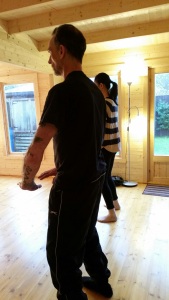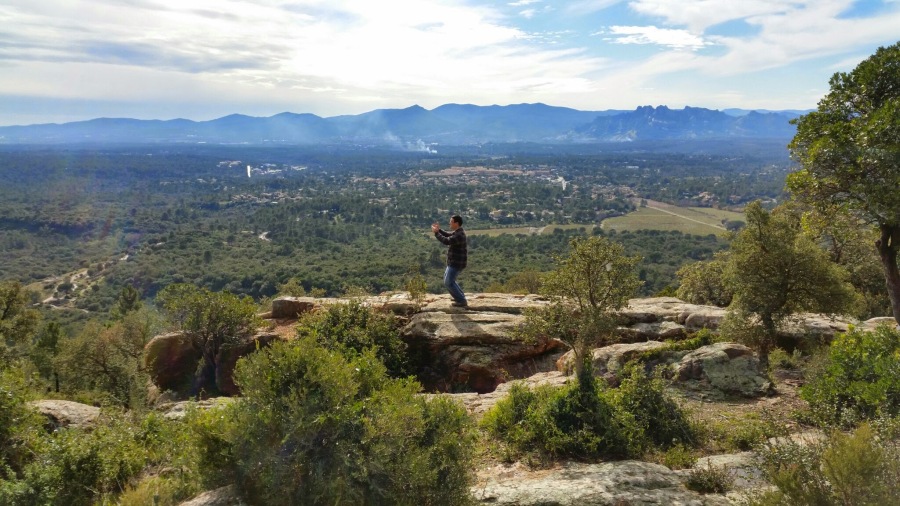
For those who are yet to experience it, standing post Chi Kung could be seen as a Chinese delicacy which is an acquired taste. Under correct guidance your first experience should be a kind of sweet agony. You know something good happened, but your body just wants to complain. It looks deceptively easy. Just stand very still with your arms in certain positions and your legs bent. If you find it easy just go lower by bending the legs more. What could be simpler? Well for those who have done it – almost anything. Yet with repetition the exercise becomes more and more generous, increasingly giving more than it seems to take from you.
The basic idea of standing post Chi Kung is to sink and relax your body’s energy whilst looking out into the distance and keeping your mind focused a couple of inches below your navel (which is roughly where your body’s centre is). Through this mechanism we are trying to re-educate the way that our mind/body system is using its energy (Chi). The Chinese have long realised that there are natural flows of energy (Chi) that exist within the body. These flows can be consciously cultivated by the mind so that our way of thinking, moving, reacting and interacting with our environment and other living creatures is always in harmony. However there is a tendency for us to disrupt this connected state in favour of using localised strength that doesn’t come from our centre and does not utilise the power of us as a whole. All these disconnected ways of doing things tend to get stuck as life experiences accumulate, pooling in certain areas and causing tensions, pains and injuries that worsen under stress and seem very much to do with our state of mind. In fact our minds often mirror these uncentered energy patterns and we may feel that our thinking is unruly, busy, darting, distracted, out of control and anything but content, mindful and in control. Over time holding unhealthy energy patterns may create diseases and health problems that really don’t need to be there. Still further down the timeline, these negative energy patterns may cause irreversible damage as our way of thinking, moving, living and interacting wears permanent ‘grooves’ in our mind/body system (for example long standing disruptions may lead to a hip wearing out, a recurring digestive disorder such as heartburn may lead to oesophageal cancer, or a ‘fixed’ way of thinking may lead to recurring life problems).

As we have discussed above, our mind sends our body’s energy all over the place based on all sorts of patterns built up over the whole of our life experiences. For example under stress we may hunch the shoulders, when standing we may slouch and put certain joints in the body under strain, when running we may hit the ground too hard, when walking we may fall forwards rather than choosing each step, when thinking we may chew our lips or knit our brows, when told off we may tense our stomach muscles and disrupt our digestive system, when washing up we may stand in a way that allows the arms to move freely at the expense of a rigid back that aches before the task is complete, etc. So as you can see we often ask the mind or body to do things without considering the effect on the whole, ending up with endless internal conflict instead of harmony and natural flow.
If you are a martial artist studying Tai Chi I hope that you are beginning to see that perhaps your way of moving, punching, blocking, kicking and thinking are similarly marred by these same internal conflicts and that these will negatively affect your combat effectiveness and make it harder to understand and progress in the world of Internal Martial Arts.

Regardless of your reason for studying Tai Chi, with a mind and body so busy with all these different energy patterns, how are you supposed to achieve the basic state of being able to feel the natural flows that exist and then go on to cultivate them? How will you make the natural flows stronger so they drown out and eventually destroy the noise of all these aberrant unnecessary patterns that create more weakness than strength? How can you begin to use these natural flows of energy to perform our daily tasks? How will you develop your internal power for health, happiness and self-defence?
To the martial artist wishing to truly access the power of internal energy these problems are even more serious. The basis of Tai Chi as an effective combat system is the ability to merge with and listen to another person’s physical and energetic person so that you can use your intention to alter what they intended (e.g. making their punch go off course without their conscious recognition, thus simultaneously protecting yourself from their blow and making them totally vulnerable to your counter attack). To do this perfectly, you must achieve stillness in motion and a soft power using the whole of your mind, body and spirit in unison. Even when being attacked your mind must not kick off disconnected energy patterns through fear, anger, past traumas or localised movement patterns cultivated over a lifetime of experience. Whereas incorrect practice for the health practitioner could mean a bit less health, incorrect practice for a martial artist could mean defeat at the hands of a protagonist you hoped your art could see off. Defeat in this context could be anything from a black eye to eternal sleep.
Master Ding has often said that standing post practice is the most powerful type of Chi Kung. To help understand why please imagine a glass of water with some sand in it. Now imagine shaking that glass so that the sand is everywhere. If you imagine that each of the grains of sand flying around in the water is some of your dispersed unruly energy you can now see that just doing the Tai Chi Form or moving Chi Kung won’t necessarily settle the sand properly. Being still whilst practising Chi Kung, relaxing within the structure you are forming with your body and keeping the mind settled on your centre gives you the time you need to settle the sand down so that it can sink to the bottom of the glass. Once your system becomes clearer you will be able to feel what your body naturally does and how it naturally wants to move energy and from there you can understand more about how to cultivate the ‘Chi’ we so often discuss.
This is why in our organisation we spend so much time on standing post Chi Kung. As beginners we struggle to do more than, say, 5 minutes. Over time we find that we can perform Chi Kung for perhaps an hour or two. Once you can do this you will really be learning stillness and the sand in your glass should be very settled.
Simultaneous with long Chi Kung practice, we also do another variant where we go very low by bending the knees as far as our mind/body system will safely tolerate. In this mode it should be hard to do more than 5 minutes Chi Kung, so we aim to do at least 8 minutes. This pressurises our systems more. What we are then learning is to keep the sand in the water settled even though we are beginning to shake the glass. You must work harder to keep still when your legs are bent – the energy circulates and expands more forcefully and so our body’s physical power develops to support a relaxed, sunken and overall more powerful way of being.
Of course there is more to Chi Kung than just this – all the concepts and principles of Tai Chi apply during its practice: for example, lifting the spirit, hollowing the chest, tucking the tailbone, sinking the shoulders, using the kuas, using intention, opening, closing, expanding energy, drawing etc, etc. All these things must be cultivated during the stillness of standing post Chi Kung.
Grandmaster Ip Tai Tak, my teacher’s teacher, was very clear when he said that there are three important parts of Tai Chi practice: Chi Kung, the Form and Push Hands. Everyone does the Form, some try Push Hands, but perhaps not enough attention is given to the importance of our standing post Chi Kung. I hope that now you can see that practicing it correctly is the underpinning to all the skills we hope to learn from our Tai Chi practice and so it must be given time in your training regime. So in the immortal words of my Sifu, Master John Ding, until next time, “More Chi Kung”.


Very good article Nick.
Keep them coming
LikeLike
Thanks Brian!
LikeLike
Thanks Nick and Rachael.
LikeLike
Thanks as ever Jill x
LikeLike
Do it every day, whether I like it or not (which I don’t, mostly).
LikeLike
It’s good for you Paul! Without it you’d feel……apaulling?
LikeLiked by 1 person
After that double ellipsis (eek!) and grievous pun, well, my perkiness after doing, as I now do daily, the long form immediately upon rising (as advised by the mighty Yang Chengfu, or Yang Ch’eng-fu, if you will, has been de-perked, somewhat. A cruel blow; well below the belt.
Ahem!
I’m rather good at taking advice from people that know what they’re talking about, such as your good self, Master Ding, Grandmaster Ip Tai Tak and Grootmeester Yang Chengfu: men that have all forgot more than I’m ever likely to know re., the Art.
Qigong (pardon my Pinyin) is strongly advised on a daily basis by all the aforementioned planet-sized brained chaps: so I do it – my joy at performing it can only be measured in Planck time, though, I’m afraid… Trumped Master Ding’s ‘100 day challenge’ again and again. Been a bit ill, recently, and qigong daily, plus the long form, now thrice daily (two ‘tiger style’ and a ‘stork style’ in the evening) has been my medicine. Simple as that.
LikeLiked by 1 person
Fantastic articles Nick, my wife and I love reading them👍
Cheers Pete
LikeLike
Thanks Peter
LikeLike
Excellent ! Thank you Nick
LikeLike
Thank you so much for taking the time to read the blog x. I appreciate it a lot.
LikeLike
For a long time I struggled to motivate myself to practice Chi Kung regularly or even often. I decided to make an effort of a short daily routine, which was around the time prior to my 6 monthly check up for high blood pressure. I noticed when checking my blood pressure after just these short Chi Kung sessions my blood pressure had dropped significantly. I thought “wow”, what if I did a lot more. Now I do, every day , as much as I can and I feel terrific.
LikeLiked by 2 people
That is such a brilliant testimony to Chi Kung practice. Thank you for sharing it with us.
LikeLike